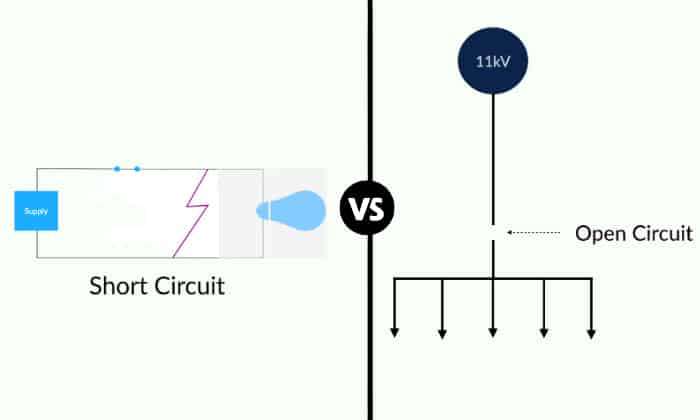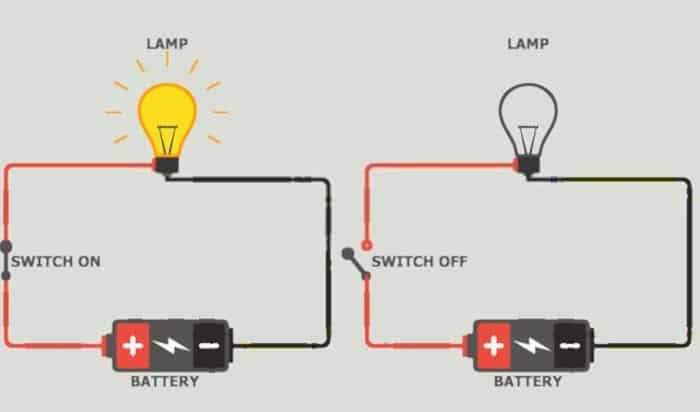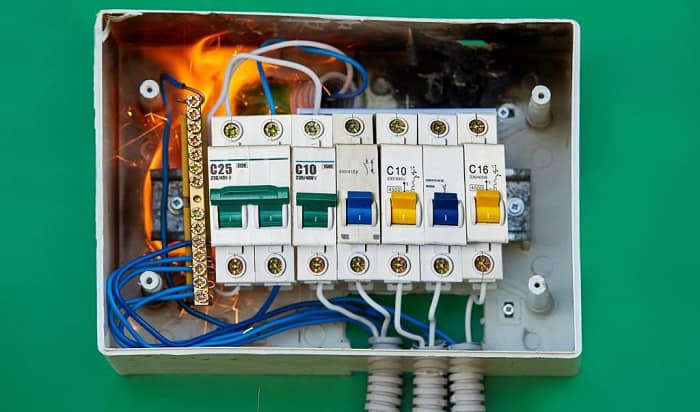When comparing open circuit vs short circuit, remember these vital points:
An open circuit is the direct opposite of a closed circuit, since its two electric terminals are disconnected whereas they’re connected in the latter. Technically, there’s infinite resistance or a break in the circuit, so no current flows through it.
Also, a short circuit is a closed circuit with little to zero resistance to the current. In most circumstances, this connotes an electrical hazard, since dangerously high levels of current may burn the conductor.
Continue reading to know more about the difference between the two.
Table of Contents
What is an Open Circuit?
For a simple definition, it’s any circuit that doesn’t let current flow through it. Now, you may be wondering why it’s called an “open” circuit if it does just that. Aren’t circuits essentially pathways for current to flow through?
Well, in this case, it’s termed as such because the circuit has been “opened” (or, more accurately, disrupted) at a certain point. There’s no return path for the current, in short. Since no current flows, open circuit resistance is practically infinite.
How Does It Work?
Let’s take, for example, a standard electric diagram that includes a battery, switch, wires, and a lightbulb. The switch determines whether the two terminals or nodes responsible for stopping or allowing current flow will connect or disconnect.
- Every time we close the switch, we get a closed circuit since the switch connects the two electrical terminals, allowing the current to reach it.
- On the other hand, the moment we open the switch, we get an open circuit, since the action disconnects the terminals and cuts off the current.
- Problems such as when a signal or power was supposed to pass failing to do so or when a path in the circuit suddenly opened up can also be called open circuits. The same goes for when a power failure occurs or a switch or circuit board is damaged, resulting in such a state.
What is a Short Circuit?
We call it a short circuit because the current takes the shortest amount of time to follow through its standard circular path.
Whether deliberately or unintentionally created, any circuit where there’s very little to no resistance (R=0) can be categorized as a short circuit.
I say “very little” because in most cases, there’s still resistance present in minuscule amounts (around 0.001 ohms or 0.10 ohm). In short, it’s so small that it becomes irrelevant (i.e. 0).
Moreover, there’s literally no short circuit voltage since, in a short circuit, the voltage also becomes zero.
Voltage is the force necessary to move an electrical charge. Since short circuit current is at maximum levels, there’s nothing keeping these charges from moving, so the said force isn’t required.
How Does It Work?
Because it’s impractical and dangerous, it’s nothing short of crazy to intentionally create short circuits, unless only to demonstrate the consequences that may arise from it.
As for what these consequences are, we don’t need to look further than our own circuits at home.
Think of instances when water accidentally (or otherwise) leaks into your electronic appliances, making its way into frayed or exposed portions of the wires.
Since water is a conductor, it’s likely to be “attracted” to the new route it makes, thus creating the short circuit.
Another common cause is when two or more nodes suddenly end up connecting because of the loss of solder over time.
- There is said to be a short circuit when the current diverts from the path where it will typically meet the most resistance and ends up in one where there’s minimal to zero of it.
- This condition results in a surge of current that the wire or conductor may not be able to handle, leading to an electrical fire.
In addition, learn a detailed guide to fixing short circuits here, if you need!
Pros and Cons of Open Circuit and Short Circuit
Overall, I see no distinct advantage in having either one. Both translate to failure in electrical design. Basically, an open circuit is just a state when an appliance isn’t being used. Where’s the value in that?
When it comes to steady current flows in both an open circuit and closed circuit, the former is not a good contender against the latter, but, given the nature of short circuits, there’s no winner here.
Of course, the cons of both awfully and glaringly stand out, such as the following:
- If a smoothly working closed circuit suddenly becomes either an open circuit or short circuit, that usually spells trouble.
- Both pave the way for serious problems like power loss and fire hazards. In short circuits, this is already obvious because you’re likely dealing with burnt-out and exposed wires.
In open circuits, no current may mean there are poor connections or other elements of the circuit showing signs of failure.
As you can see, there are actually more similarities between the two, which is kind of ironic in this open vs short circuit conversation.
The Main Things that Set Open Circuits and Short Circuits Apart
This short circuit vs open circuit comparison can’t be complete without summing up what makes one different from the other. Here are the most important distinctions:
- An open circuit is an electrical network where there’s zero current, while a short circuit is a state where there’s maximum current due to zero resistance.
- The issues that result in them largely differ, too. Short circuits are more likely to happen due to insulation failure, faulty connections, or two live wires suddenly making contact.
Open circuits may arise due to manual interruptions, overheating, and component failures, besides the causes I’ve mentioned above.
- In open circuits, there’s likely a high voltage drop, while in short circuits, the only thing that’s high is the current.
Is a Short Circuit Closed or Open?
It’s a closed circuit since there’s nothing interrupting and preventing the current from completing the return path. The downside is that the surging, unresisted current may burn the wires.
Open Circuit Fault and Short Circuit Fault: What is the Difference?
If the current flow where it’s not supposed to flow, then it’s a short circuit fault. In more technical terms, it’s when two neighboring nodes become wrongly connected.
If the current stops as a result of two normally connected nodes breaking apart, then an open circuit fault occurs.
These faults can be caused by the electrical problems I said above.
Conclusion
I hope this brief physics discussion regarding open circuit vs short circuit cleared up all the lingering confusion you have about the two. To sum up:
- A short circuit involves an electrical network with current that flows unrestrictedly and usually erratically due to the complete absence of resistance.
- An open circuit is one where the current’s flow is stopped due to a manual or accidental disconnection of two circuit terminals.
Recommended post: Ground Fault Vs Short Circuit – Detailed Comparison

I am Edwin Jones, in charge of designing content for Galvinpower. I aspire to use my experiences in marketing to create reliable and necessary information to help our readers. It has been fun to work with Andrew and apply his incredible knowledge to our content.



